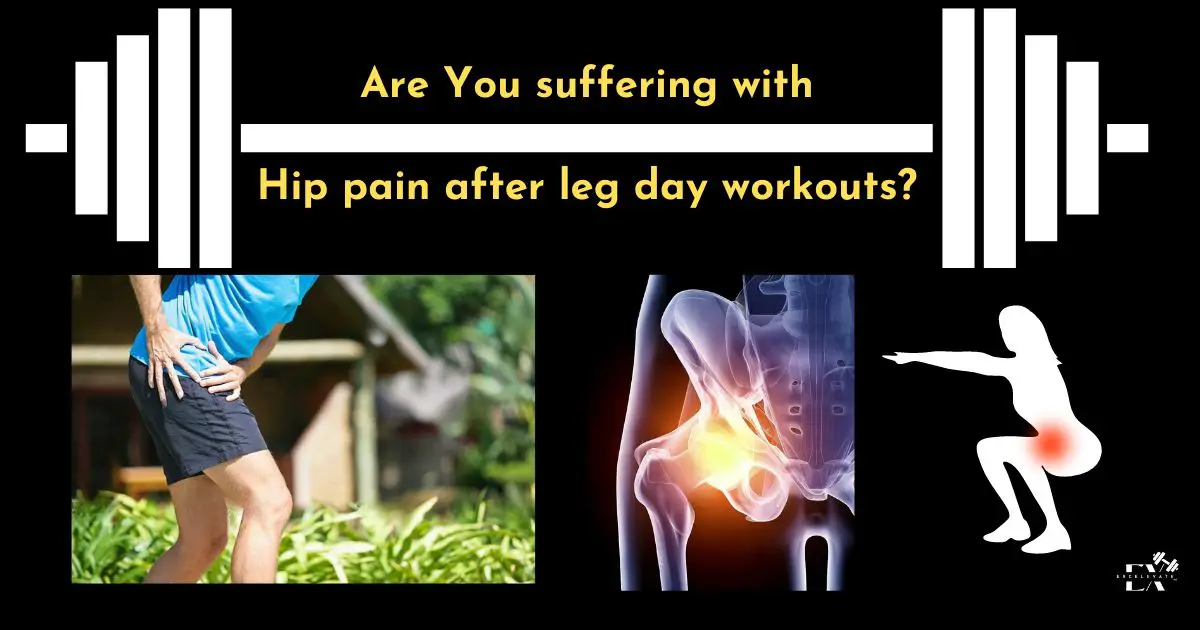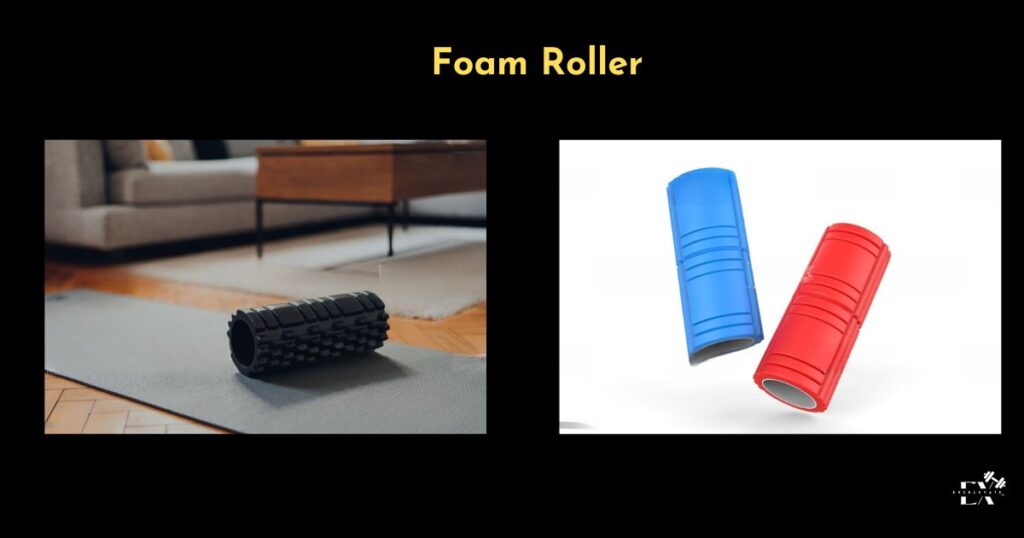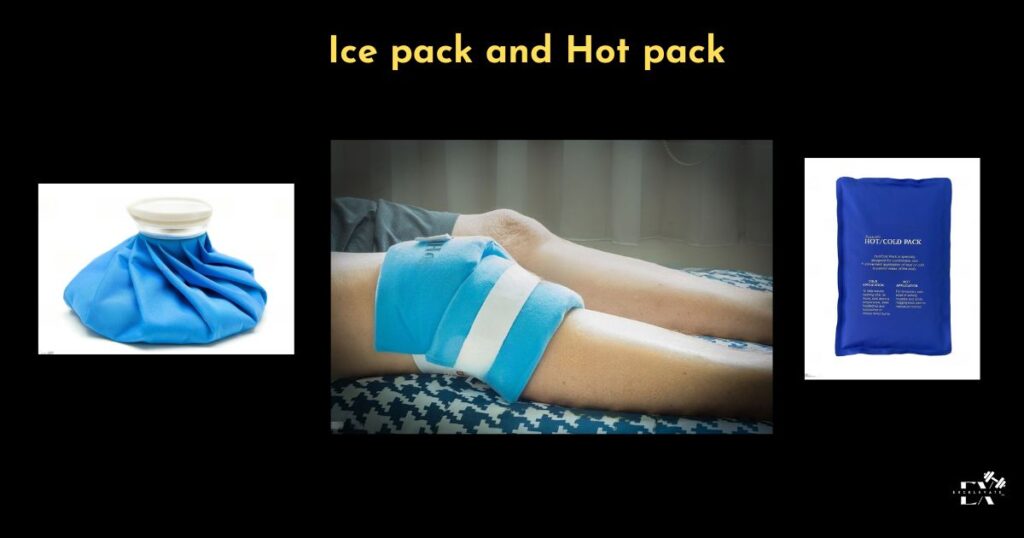
After a rigorous leg day workout at the gym, it’s not uncommon to experience some level of hip discomfort. That twinge or soreness around the hip area can be quite bothersome, but rest assured, you’re not alone.
Hip pain after intense leg workouts is a common occurrence among fitness enthusiasts and athletes. However, understanding the root causes and learning how to manage it can help you stay on track with your fitness goals and maintain a healthy, pain-free body.
Let’s Picture this: You’ve pushed yourself through squats, lunges, and deadlifts, all aimed at building strong and powerful legs. While these exercises do wonders for overall fitness, they also engage the hip muscles significantly. Consequently, you may find yourself experiencing hip pain post-workout. This discomfort can range from mild soreness to more intense sensations, making it crucial to address and manage effectively.
In this blog post, we’ll delve into the anatomy of the hip and its involvement in leg exercises. We’ll explore the possible causes of hip pain after leg day, from muscle soreness due to micro-tears to improper form or overexertion. By understanding these factors, you’ll be better equipped to prevent discomfort in the future.
We’ll also share practical tips on preventing hip pain, including the importance of proper warm-up and cool-down routines, scaling workout intensity, and allowing ample time for muscle recovery.
Moreover, we’ll discuss post-workout recovery strategies such as stretching, foam rolling, and targeted nutrition to ease inflammation and soreness.
Remember, hip pain should never be ignored. If it persists or worsens, seeking medical attention is crucial to rule out any underlying issues.
By prioritizing hip health and incorporating proper techniques and recovery strategies, you can continue to embrace leg day workouts while keeping discomfort at bay, ensuring a rewarding and sustainable fitness journey.
Understanding Hip Pain After Leg Day
The Anatomy of the Hip and its Involvement in Leg Exercises
Before we delve into the reasons behind hip pain after leg day workouts, it’s essential to understand the intricate anatomy of the hip. The hip joint is a ball-and-socket joint connecting the femur (thigh bone) to the pelvis.
It is supported by a network of muscles, ligaments, and tendons that facilitate movement and stability.
The hip plays a crucial role in coordinating various movements during leg exercises like squats, lunges, and deadlifts. The hip flexors and extensors work harmoniously to lift the legs, while the glutes and adductors help stabilize and control the motion.
These muscles work in tandem to generate power and provide balance during lower-body movements.

Potential Causes of Hip Pain After Leg Day
Hip pain after intense leg workouts can result from a combination of factors. Muscle soreness is a common occurrence due to micro-tears in the muscle fibres caused by the stress of exercise. However, excessive muscle soreness can lead to discomfort around the hip area.
Overuse is another culprit, especially if leg exercises are performed too frequently or with inadequate rest between sessions. This can strain the hip muscles, leading to pain and inflammation.
Incorrect form during leg exercises can also contribute to hip pain. Poor alignment or improper technique places unnecessary stress on the hip joint and surrounding muscles, increasing the risk of injury.
Differentiating Acute Pain from Chronic Pain and Seeking Medical Advice
It’s crucial to differentiate between acute pain and chronic pain. Acute pain is typically temporary and arises immediately after intense physical activity. It often subsides with rest and proper post-workout recovery techniques.
On the other hand, chronic pain is persistent and lasts for an extended period, even beyond the recovery phase.
If you experience chronic hip pain after leg day, it’s essential to seek professional medical advice. Persistent pain may indicate an underlying issue, such as tendinitis, bursitis, or a more severe musculoskeletal problem.
Common Leg Exercises and Their Impact on the Hips
Leg Exercises Leading to Hip Discomfort
Leg day workouts are notorious for their ability to leave us with lingering hip discomfort. Several popular leg exercises are known culprits for this sensation. Squats, lunges, deadlifts, and leg presses are among the most common exercises that can lead to hip strain.
Engaging the Hip Muscles and Surrounding Structures
Squats: Squats are fantastic for building overall lower body strength. During squats, the hip muscles, including the glutes, hip flexors, and adductors, are heavily engaged to support the weight and facilitate proper form.
Lunges: Lunges target the quadriceps, hamstrings, and glutes, but they also require hip stability and control. The hip muscles play a crucial role in maintaining balance and executing the movement smoothly.
Deadlifts: Deadlifts primarily target the hamstrings, glutes, and lower back. The hip extensors, such as the gluteus maximus, are significantly activated during the lifting phase.
Leg Presses: Leg presses focus on the quads, hamstrings, and glutes. While the primary emphasis is on the legs, the hips still play a supporting role in stabilizing the movement.
The Importance of Proper Technique and Alignment
To reduce hip strain during leg exercises, it is essential to prioritize proper technique and alignment. Incorrect form can place excessive stress on the hip joint and surrounding muscles, leading to pain and discomfort.
Maintaining a neutral spine and proper knee alignment during squats and lunges is crucial. Avoiding excessive forward lean and ensuring the knees do not collapse inward will help reduce pressure on the hips.
For deadlifts, maintaining a strong hip hinge with a neutral spine is vital. Engaging the core and glutes will support the back and minimize strain on the hips.
During leg presses, ensure that the feet are placed in a comfortable position on the platform. Avoid locking out the knees and keep the movement controlled to prevent unnecessary stress on the hips.
Prevention Tips to Minimize Hip Pain
Warm-up and Cool-down Routines Targeting Hip Flexibility and Mobility
Preventing hip pain after leg day starts with a comprehensive warm-up and cool-down routine. Prior to the workout, spend 5-10 minutes performing dynamic stretches that focus on the hip area.
Leg swings, hip circles, and high knees are excellent choices to increase blood flow, improve hip flexibility, and prepare the muscles for the upcoming intensity.
After the workout, engage in static stretches that specifically target the hip muscles, such as hip flexor stretches and pigeon poses, to ease tension and promote faster recovery.
Properly Scaling and Progressing Leg Exercises
Overexertion during leg exercises can place unnecessary strain on the hips, leading to discomfort and potential injuries. Proper scaling and progression of leg exercises are crucial to minimizing hip pain.
Gradually increase the intensity and weight of the exercises, allowing the hip muscles to adapt and grow stronger over time. Avoid the temptation to lift heavy weights without first mastering the correct form and technique.
Incorporating Rest Days into the Workout Routine
Rest days are just as important as workout days when it comes to preventing hip pain. Giving your hip muscles time to recover and repair themselves is essential for avoiding overuse injuries.
Aim for at least one or two rest days per week, allowing your body ample time to heal and rejuvenate. On these days, you can engage in gentle activities like walking, swimming, or yoga to maintain mobility without placing excessive stress on the hips.

The Role of Cross-Training and Balancing Workouts
While leg-focused workouts are essential for building lower body strength, incorporating cross-training is beneficial for hip health. Engage in exercises that target other muscle groups, such as upper body workouts or core exercises.
This approach helps to balance your overall fitness routine and prevents overloading the hip muscles. Additionally, cross-training provides a refreshing change of pace and reduces the risk of burnout.
Tips for Post-Workout Recovery
Importance of Stretching Exercises for Hip Flexibility and Soreness Reduction
Post-workout stretching is a crucial step in promoting hip flexibility and reducing soreness. After intense leg exercises, the hip muscles can become tight and tense. Incorporate static stretching exercises that specifically target the hip area, holding each stretch for 15-30 seconds to release tension and improve flexibility.
Stretching not only enhances blood circulation but also aids in preventing future injuries by maintaining an optimal range of motion in the hip joints.
Utilizing Foam Rolling Techniques to Release Hip Muscle Tension
Foam rolling is a valuable self-massage technique that targets tight and knotted muscles. To alleviate tension in the hip area, use a foam roller to gently roll over the glutes, hip flexors, and adductors.
This practice helps break up adhesions and trigger points, promoting blood flow and aiding in muscle recovery. Foam rolling should be performed gradually and with controlled movements to avoid exacerbating any existing discomfort.

Application of Ice or Heat Therapy for Inflammation and Discomfort
After intense leg day workouts, it’s common to experience inflammation in the hip muscles. Applying ice or heat therapy can provide relief and aid in the recovery process. Ice packs can help reduce swelling and numb the area, while heat packs can relax tight muscles and improve blood flow.
Use ice for acute pain and inflammation, and heat for chronic or lingering soreness. Be sure to wrap the ice or heat pack in a cloth and avoid applying directly to the skin

The Significance of Proper Nutrition and Hydration in the Recovery Process
Post-workout recovery isn’t just about physical practices; it also involves providing the body with the right nutrients and hydration. Consuming a balanced meal or snack containing a mix of protein and carbohydrates within an hour after exercise helps replenish glycogen stores and repair muscle tissue.
Staying adequately hydrated is also essential to flush out toxins and maintain overall bodily functions. Drinking plenty of water throughout the day ensures optimal recovery and performance during future workouts.
Flexibility and Stretching: Unlocking the Benefits of Hip Flexibility
Importance of Hip Flexibility: Exploring the Benefits of Flexible Hip Muscles
Hip flexibility is a key component of overall physical health and fitness. Flexible hip muscles not only enhance athletic performance but also contribute to daily activities and reduce the risk of injuries.
During leg day workouts, the hips play a significant role in various exercises, making it essential to prioritize their flexibility.
Improved hip flexibility allows for a broader range of motion, enabling better form and technique during exercises like squats, lunges, and deadlifts. This, in turn, enhances muscle engagement and ensures a more effective workout.
Beyond the gym, flexible hips positively impact daily activities such as walking, running, and bending. Tight hip muscles can lead to imbalances and postural issues, which can cause discomfort and limit mobility.
By maintaining hip flexibility, you can prevent muscle imbalances and reduce the likelihood of lower back pain and other musculoskeletal problems.
Recommended Stretches: Effective Hip Stretches for the Post-Leg Day Routine
Hip Flexor Stretch: Kneel on one knee, with the other leg bent at a 90-degree angle in front. Gently lean forward, keeping your back straight, to stretch the hip flexor of the kneeling leg.
Pigeon Pose: Sit with one leg extended straight and the other bent, foot touching the opposite inner thigh. Lean forward over the bent leg to feel the stretch in the outer hip of the extended leg.
Butterfly Stretch: Sit with your feet together and knees bent outwards. Hold your feet and gently press your knees towards the floor to stretch the hip adductors.
Figure Four Stretch: Lie on your back and cross one ankle over the opposite knee. Grab the thigh of the supporting leg and gently pull it toward your chest to stretch the hip and glutes.
Lizard Pose: From a plank position, step one foot forward between your hands. Lower your forearms to the ground and sink your hips down to feel the stretch in the hip flexors.
Incorporate these hip stretches into your post-leg day routine to enhance flexibility, reduce muscle tension, and promote faster recovery. Remember to perform each stretch gently and hold for at least 20-30 seconds to allow the muscles to relax and lengthen effectively.
Nutrition for Hip Health: Nourishing Your Joints From Within
Anti-Inflammatory Diet: Foods to Promote Joint Health and Reduce Inflammation
Maintaining proper nutrition is not only crucial for overall well-being but also plays a vital role in supporting hip health.
An anti-inflammatory diet can help reduce inflammation in the body and promote the health of your hip joints. Include foods rich in omega-3 fatty acids, such as fatty fish (salmon), flaxseeds, and chia seeds. These fatty acids possess potent anti-inflammatory properties that can alleviate hip discomfort.
Incorporate colourful fruits and vegetables into your diet, especially those high in antioxidants like berries, cherries, and leafy greens.
Antioxidants combat free radicals and oxidative stress, which contribute to joint inflammation. Nuts and seeds, such as almonds, walnuts, and pumpkin seeds, are also beneficial due to their anti-inflammatory properties and rich nutrient content.
Hydration: The Key to Joint Lubrication and Overall Health
Staying adequately hydrated is essential for the lubrication of joints, including the hips. Water is a vital component of synovial fluid, which acts as a lubricant and cushion for the joints. Drinking enough water ensures that your hip joints remain well-lubricated, reducing friction and promoting smooth movements during workouts and daily activities.
Aside from water, incorporate hydrating foods into your diet, such as cucumbers, watermelon, and oranges. These water-rich foods contribute to your daily fluid intake and support joint health.
Remember that hydration needs may vary depending on factors like activity level and climate, so listen to your body’s thirst cues and adjust your water intake accordingly.
Knowing When to Seek Medical Attention for Hip Pain After Leg Day
Recognizing Warning Signs Requiring Medical Evaluation
Hip pain after leg day workouts is often a normal response to intense exercise, but certain warning signs warrant medical attention. If you experience severe, sharp, or persistent pain that worsens with movement, it may indicate an injury beyond typical muscle soreness.
Additionally, swelling, redness, or warmth around the hip joint could signify inflammation or an underlying issue.
Feeling a popping sensation or experiencing instability in the hip joint during or after exercise should not be ignored. Such symptoms might indicate a ligament or joint problem that requires medical assessment.
Potential Underlying Issues Contributing to Hip Pain After Leg Day
Various underlying issues could be contributing to hip pain after leg day workouts. Tendinitis, an inflammation of the tendons, is common due to overuse or incorrect form during leg exercises.
Bursitis, an inflammation of the fluid-filled sacs in the hip, can also be triggered by excessive pressure on the joint.
Hip impingement or labral tears, which are structural issues within the hip joint, may cause pain during certain movements.
Muscle strains and stress fractures can occur with repetitive or excessive exercise, leading to hip discomfort.
Consultation with Healthcare Professionals for Proper Diagnosis and Treatment
If you experience any of the warning signs or underlying issues mentioned, it is essential to seek medical attention promptly.
Consulting with a healthcare professional, such as a sports medicine specialist or orthopaedic doctor, will ensure a proper diagnosis and appropriate treatment plan.
They can conduct a thorough examination, possibly including imaging tests like X-rays or MRI, to identify the root cause of the hip pain.
Delaying medical evaluation can lead to prolonged discomfort and potential worsening of the condition. Early intervention can facilitate a faster recovery and prevent further complications.
Additionally, healthcare professionals can provide personalized advice on modifying workouts, implementing physical therapy, or exploring other treatments to support hip health.
In conclusion, our blog post highlighted the importance of understanding and managing hip pain after intense leg day workouts. We explored the anatomy of the hip and its involvement in leg exercises, identifying potential causes of hip discomfort such as overuse and incorrect form. To prevent hip pain, we discussed the significance of warm-up and cool-down routines, proper scaling of exercises, rest days, and cross-training.
Emphasizing the importance of hip flexibility and post-workout recovery, we suggested effective stretches, foam rolling techniques, and ice or heat therapy. Furthermore, we delved into nutrition and hydration’s role in supporting hip health.
By recognizing warning signs and seeking medical attention when needed, readers can take proactive steps to address any underlying issues. Ultimately, prioritizing proper workout techniques, rest, and recovery is crucial in preventing hip pain after leg day and ensuring a sustainable fitness journey. Remember, a healthy hip is the foundation for achieving fitness goals and embracing an active lifestyle.
Thanks for Reading.
Follow us on
FAQ
How do you get rid of hip pain after working out?
Experiencing hip pain after a workout can be frustrating, but there are ways to find relief. Rest and gentle stretching can help alleviate soreness and improve flexibility. Applying ice or heat to the affected area may reduce inflammation. If pain persists, seeking professional advice and modifying your workout routine can aid in recovery and prevent future discomfort. Remember, taking care of your hips is crucial for a successful fitness journey.
How to relieve hip pain after exercise?
Hip pain after exercise can be eased with simple strategies. Engage in gentle stretches targeting hip muscles to reduce tension. Consider using a foam roller to massage and release tightness. Applying ice or heat to the affected area may reduce inflammation. Adequate rest and hydration support the recovery process. If pain persists, consult a healthcare professional for proper assessment and personalized advice.
Why do my hips hurt after leg raises?
Experiencing hip pain after leg raises is common due to the engagement of hip flexor muscles during the exercise. Leg raises involve lifting your legs while lying down, which can strain these muscles. Ensure proper form and avoid excessive movements to reduce stress on the hips. Incorporate hip stretches and strengthening exercises to support your hip health and prevent discomfort.
Why do my hips hurt day after squats?
Experiencing hip pain the day after squats is often due to muscle soreness and micro-tears caused by the intensity of the exercise. Squats engage the hip muscles significantly, leading to post-workout discomfort. Warm-up properly, use correct form, and gradually increase the intensity of squats. Gentle stretches and rest can help ease the pain, while consistent training will improve hip strength and reduce future soreness.
Is hip pain normal after workout?
Experiencing mild hip discomfort after a workout is normal, especially if it involves intense leg exercises. Leg day workouts engage the hip muscles, leading to temporary soreness. However, severe or persistent pain, swelling, or instability is not normal and should be evaluated by a healthcare professional. Listen to your body, practice proper form, and prioritize post-workout recovery to ensure a safe and effective fitness journey.
